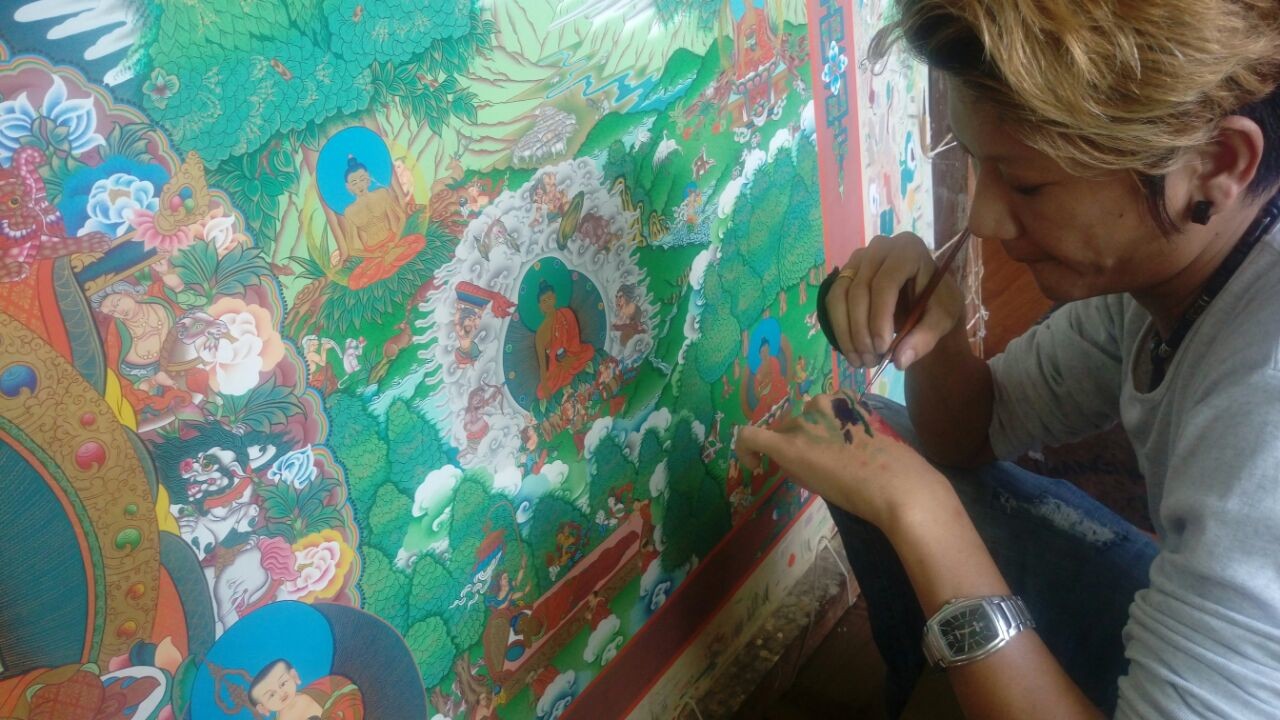Azadi Through Tibetan Art

Conquerors are not the people who never fail but people who never loose. Tibetans residing in the pristine locales of Dharamshala and the adjoining areas consider that art is the only way to create home away from home. Their art is a scream for freedom. The awe inspiring art work generated is an effort to create a more humane world.
If one needs to understand the intricacies of their art, its themes and execution, one has to peep inside the world of Norbulingka Institute in Dharamshala in Himachal Pradesh. Everything here has a story to tell. Norbulingka means a jewel park in Tibetan. The institute found in 1990 is made in the shape of a thousand armed Avalokiteshvara and takes its name from the Dalai Lama’s summer palace in Lhasa.
The Gandhian concept of tranquility amidst autonomy, what can also be described as Gandhian socialism, hums in the blooming and unsullied gardens of Norbulingka.The techniques of these art forms are developed by the artists themselves. A large number of the artifacts created here are exported. In fact it is in this institute in this nanoscopic small village of Sidhpur that the Make in India concept is visible.
Tenzin took this reporter around the place giving details of its soulful structure amidst the air of artistry. The artists and their masters up skill divergent art forms here but the process of completion of every piece includes a lot of forbearance, perseverance and ardor.
Among the specialty of this place is the Thangka paintings, a work of very superior art. The colours used are bought in the form of mineral stones either from Rajasthan or from Nepal. It take around two months for the artist to rub it in another stone bowl and turn it into powder to be used as colour.
Thangka is a sacred Tibetan art based on the proportions of Buddhist deities.Tenzin Thinley a Thangka artist with hands on experience of 23 years came to the institute in early 1990’s and started working as a construction labourer. He said learning Thangka was his sole objective. Initially the course was for six years which has now been reduced to three years. “Exact measurements, minute details, predefined colour scheme are the basics of the detailed paintings. For Thangka we follow ' Mentri' style which is the oldest,” he said.
Tenzin sits for nine to ten hours a day ,taking only an hour long lunch break, making the Thangka paintings. Some of them take a month to finish while others take years. He was one of the artists who made the biography of the Dalai Lama.
“That particular Thangka painting took 12 long years to complete. It was started in 2002 and they finished it in 2014,” Tenzin recalls with a smile.
“These days it is easy to learn. Genta (Guru) use to hit us with a stick when we made mistakes in those days,” he says.
Every Thangka goes through many stages of scanning before it is cleared for sale. The minutest mistake is not ignored as these paintings are used by the practitioners in meditation and devotional practices.
The other beautiful creations being brought out by this institute is Applique. The technique of Applique is called “couching” and is done by first wrapping silk thread around a hair from the tail of a Mongolian horse and then stitching this cord onto fabric to create bold outline. The silk used is Banarasi .They start the process by applying a layer of an adhesive on silk. As in Thangka, the colours are pre decided here. It is a very time consuming job that needs precision and accuracy. Small pieces of silk are cut according to the drawing then they are layered together to create a patchwork effect.
This section has a lot of women workers. The institute works on the bonding with its helping hands. The ladies working here have the assistance of a nunnery in which they can bring their kids as small as one month and work without any tension here. As the kids grow up, they have a kindergarten and a creche.
Jhamphel Wangmo, an Applique artist says, “The kids grow in a very loving environment and are comparatively intelligent as well.”
The institute also teaches wood carving and wood painting. The former is a special technique of relief painting which gives a three dimensional look to the design. The perfection of this artist speaks volumes on the walls of the institute.
In wood carving they teach eight auspicious symbols or designs of Tashi Targye. Students take help of variety of tools but none of the machines are used.They have regular workshops attended by students from all over the world. The curriculum is flexible..
In Norbulingka the Tibetan artists work in silence and let their popularity be their noise. A nation’s strength ultimately consists in what it can do on its own and not in what it can borrow from others. Here is a full race is working day in and day out contributing to the Make in India initiative.



